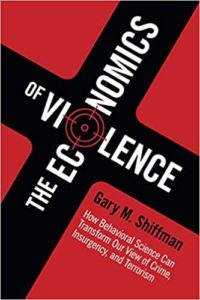If we want to combat violence in the world, what’s the best way to go about it? Perhaps thinking of people like Pablo Escobar, Joseph Kony, and Osama Bin Laden as criminals is insufficient. What if we were to think of them instead as entrepreneurs? What if we assessed their actions and organization as a venture capitalist, rather than a politician or soldier?

These questions are at the heart of the work of Gary Shiffman, who EconTalk host Russ Roberts welcomed to talk about his book, The Economics of Violence, in this episode. Shiffman became an economist after a career in the military to understand conflict, violence, and coercion in the world. We’d like to hear what you took away from this week’s conversation. We’d love for you to share your thoughts- with us here or offline with others. Together we can keep the conversation going.
1- What’s wrong with thinking about terrorism as a religious issue, according to Shiffman?
2- What are “fictive kinships,” and how does this concept add to Shiffman’s entrepreneurship framework?
3- Consider Shiffman’s three “case studies” as entrepreneurs. Roberts reminds us all three died violent deaths at a young age. As Roberts asks, how is this rational??? To what extent are cases such as these really comparable to famous legitimate CEOs?
4- What does Roberts mean when he said, “The idea that you could make something illegal and therefore solve it is really important.” Consider the case of Escobar. Which government- the American or Colombian- had stronger incentives for the drug trade to be illegal?
5-Shiffman argues that understanding the incentives, institutions, norms, values that folks have can not only help us understand violence, but also fight it. To what extent has Shiffman convinced you?


READER COMMENTS
John Alcorn
Jan 23 2021 at 3:21pm
1. Innumeracy. Terrorists are few. Few adherents of any major faith are terrorists.
2. Loyalty to organizations. Entrepreneurs build organizations. In order to compete effectively, entrepreneurs assess strengths and weaknesses of rival organizations, not unlike Harvard Business School case studies.
3. Entrepreneurs in illicit markets are individuals who have one or more of the following characteristics:
(a) Peculiar opportunities (exposure to crime networks) and constraints (little prospect of major legal social mobility).
(b) Idiosyncratic preferences (attitudes toward acute risk; time horizon).
(c) Specific comparative advantage (an edge in coercion, an edge in information-gathering or secrecy, or an edge in creative advertising of illicit goods and services).
(4) Positions in government, politics, or law enforcement that can be exploited for corruption with criminal organizations.
Rationality is intrinsically subjective, and often difficult or elusive under uncertainty: Clarify your goal, get your beliefs reasonably straight about circumstances and mechanisms, consult your risk preference and time preference, and choose the course of action that seems most likely to achieve your goal accordingly.
4. Colombia is the supply side, the USA the demand side. Prohibition places Colombia’s government at risk of corruption or even ‘capture’ by cartel entrepreneurs. Prohibition places the USA at risk of an endless War on Drugs (high incarceration rates, disparate racial impact, criminalization of addicts, etc etc etc) — and gives US government incentive to intrude in Colombia’s policy. Moreover, perverse incentives emerge to entrench prohibition. Bad equilibria all around.
5. A puzzle lingers. If the remedy, by a democratic government, is to act like an entrepreneur against illegal drug cartels, then legalization of vice drugs seems the surest policy. Presumably, pharmaceutical firms would replace illicit drug cartels. But Dr. Schiffman seems to mean something else by his phrase, “to fight like an entrepreneur”. He seems to take prohibition as a given (a constraint), and seems to propose economic analysis as a tool for finding clever new ways to defeat illicit suppliers and to suppress the supply side of the market.
Comments are closed.